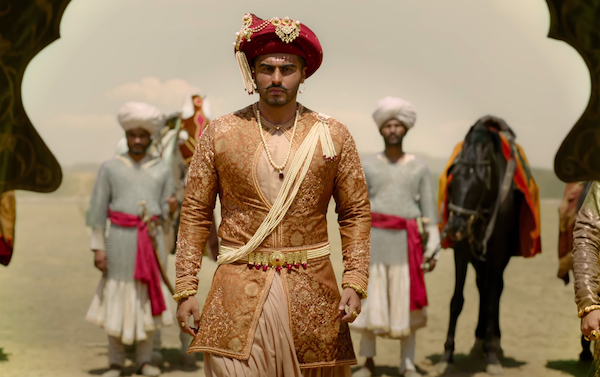
Ashutosh Gowariker’s filmography until the release of Panipat includes three very good films—Lagaan, Swades and Jodhaa Akbar—and three embarrassingly bad ones—What’s Your Raashee, Khelein Hum Jee Jaan Sey and Mohenjo Daro, not counting the director’s first two efforts at directing.
His latest epic, the Arjun Kapoor-Kriti Sanon-starrer Panipat, tells the story of the third battle witnessed at the legendary site—the Afghan invaders were, according to the film, sought by Mughals to cut down the rising influence of the Maratha Empire in North India. As news of Afghan ruler Ahmad Shah Abdali’s (Sanjay Dutt) vicious plans to contain the Marathas reaches Pune, the Nana Saheb Peshwa (Mohnish Bahl) dispatches a small cavalry led by Sadashiv Rao (Kapoor) to the north, which results in the third battle of Panipat.
While Panipat may be set in the 18th century, it has a lot in common with present-day politics: in-fighting, ideological clashes, hunger for power and a brutal tyrant. But more on that later.
For the latest news and more, follow HuffPost India on Twitter, Facebook, and subscribe to our newsletter.
After the brazenly Islamophobic Kesari, which was preceded by the equally troubling Padmaavat (2018), films seething with antagonism towards Muslims seem to be Bollywood’s favourite flavour these days, an ideological position that coincidently aligns with that of India’s current government, the Hindu nationalist BJP.
However, in Panipat, a film that has the subtlety of an Ekta Kapoor soap opera, Gowariker treads the ethno-religious dynamic with utmost caution. He projects his protagonist Sadashiv as a leader who is inclusive but also drops enough hints to suggest that the Marathas weren’t. The contribution of Muslims, especially Ibrahim Khan (Nawab Shah), in amping up the artillery of the Maratha Empire was significant and Panipat consciously foregrounds his track: he’s the man leading from the front.
On the flip side, Dutt’s Abdali is docile compared with Ranveer Singh’s Alauddin Khilji (which isn’t saying much as the Afghans as a community are still depicted as homogenised caricatures). Abdali is menacing and brutal ― he’s the villain of the film, after all ― but not as barbaric as Sanjay Leela Bhansali would show him to be. His other ally, Najib ad-Dawlah (Mantra) is shown as someone who’s constantly unsure of his motives and allegiance, adding an interesting layer of complexity to what could’ve been a one-note character.
More critically, the film’s tagline, ‘the great betrayal’ carries a duality: it’s a reference to the Mughals, yes, but also to a Maratha ally who backstabbed them at a time when they needed him the most.
Now, while Gowariker is able to paint a complex portrait of 18th century India in Panipat, it’s his execution and treatment that lessen the strength of what could’ve been a compelling narrative. Gowariker’s direction evokes a television drama aesthetic. A scheming queen (Padmini Kolhapure) is introduced with a sinister background score while a sense of shock, say, when Sadashiv learns of a soldier’s death, is conveyed through the kind of score we’d see in a Balaji show, the camera zooming in on the character thrice.
The over-reliance on cacophonic background score to propel the drama reveals serious narrative insecurity. Some of the transitions in the film are hastily done: I spotted at least two that appeared to have been borrowed from a Powerpoint presentation.
So, despite the scale of the film (shot by C.K. Muraleedharan) and some impressively crafted war sequences, Panipat has a dated feel. The banter between characters, especially the interactions between Parvati (Sanon) and Sadashiv, ring false and inauthentic and despite a considerable amount of time dedicated to build their romance (so as to raise the climactic stakes), not once do you feel like rooting for them. Instead of having certain exchanges entirely in Marathi, Gowariker opts for just a line or two in Marathi, while the rest is in Hindi, something that feels out of place in the film’s milieu.
A large part of this also has to do with the performances. While Dutt hams the hell out of his role, as if how intimidating he can be is directly proportional to how loudly he screeches, Kapoor is underwhelming. He’s stoic and wooden. His expressions neither convey adequate rage, nor does his body language carry the militant conviction required for the part. If he himself looks exhausted and hungover, what inspiration will his battalion find? As for Sanon, she’s spunky and sprightly and the film gives her enough meat to play with. For a change, here’s a war movie that has imagined a part for a woman that isn’t tokenist but meaningfully propels the narrative
Often, historical dramas tell us more about our present than they do about history.
What does the battle of Panipat and its present-day depiction tell us about ourselves? While watching the film, it’s hard to not think of the surprising and ideologically-clashing alliance that emerged in Maharashtra (Shiv Sena-NCP-Congress) to keep the BJP in check.
In Panipat, as the Marathas proceed towards the North, they forge a series of uncomfortable alliances and form several coalitions to ward off the tyrant Abdali. It goes on to say that times may have changed but the greed for power and control over people still remains the core of politics.
Ultimately, the tyrant wins, but only because the coalition collapses due to an unexpected betrayal. Maybe there’s a lesson in here somewhere for the present government in Maharashtra.